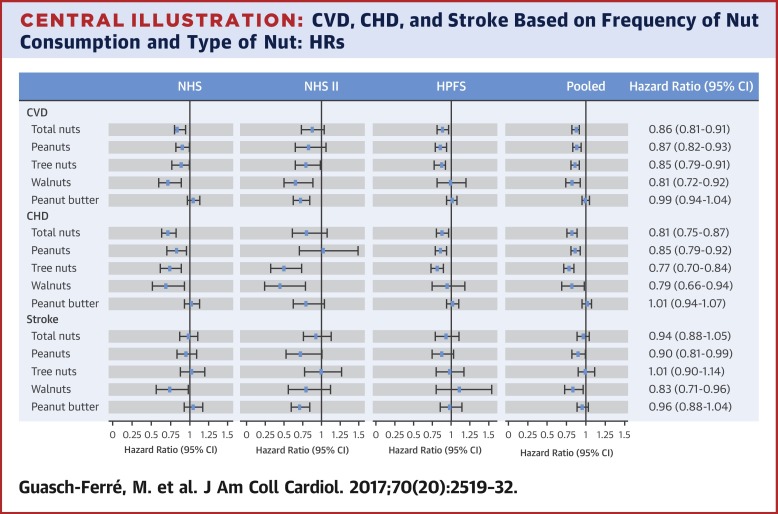当前位置:
X-MOL 学术
›
J. Am. Coll. Cardiol.
›
论文详情
Our official English website, www.x-mol.net, welcomes your
feedback! (Note: you will need to create a separate account there.)
Nut Consumption and Risk of Cardiovascular Disease
Journal of the American College of Cardiology ( IF 21.7 ) Pub Date : 2017-11-01 , DOI: 10.1016/j.jacc.2017.09.035 Marta Guasch-Ferré 1 , Xiaoran Liu 1 , Vasanti S Malik 2 , Qi Sun 2 , Walter C Willett 3 , JoAnn E Manson 4 , Kathryn M Rexrode 4 , Yanping Li 1 , Frank B Hu 3 , Shilpa N Bhupathiraju 2
Journal of the American College of Cardiology ( IF 21.7 ) Pub Date : 2017-11-01 , DOI: 10.1016/j.jacc.2017.09.035 Marta Guasch-Ferré 1 , Xiaoran Liu 1 , Vasanti S Malik 2 , Qi Sun 2 , Walter C Willett 3 , JoAnn E Manson 4 , Kathryn M Rexrode 4 , Yanping Li 1 , Frank B Hu 3 , Shilpa N Bhupathiraju 2
Affiliation

|
BACKGROUND
The associations between specific types of nuts, specifically peanuts and walnuts, and cardiovascular disease remain unclear. OBJECTIVES
The authors sought to analyze the associations between the intake of total and specific types of nuts and cardiovascular disease, coronary heart disease, and stroke risk. METHODS
The authors included 76,364 women from the Nurses' Health Study (1980 to 2012), 92,946 women from the Nurses' Health Study II (1991 to 2013), and 41,526 men from the Health Professionals Follow-Up Study (1986 to 2012) who were free of cancer, heart disease, and stroke at baseline. Nut consumption was assessed using food frequency questionnaires at baseline and was updated every 4 years. RESULTS
During 5,063,439 person-years of follow-up, the authors documented 14,136 incident cardiovascular disease cases, including 8,390 coronary heart disease cases and 5,910 stroke cases. Total nut consumption was inversely associated with total cardiovascular disease and coronary heart disease after adjustment for cardiovascular risk factors. The pooled multivariable hazard ratios for cardiovascular disease and coronary heart disease among participants who consumed 1 serving of nuts (28 g) 5 or more times per week, compared with the reference category (never or almost never), were 0.86 (95% confidence interval: 0.79 to 0.93; p for trend = 0.0002) and 0.80 (95% confidence interval: 0.72 to 0.89; p for trend <0.001), respectively. Consumption of peanuts and tree nuts (2 or more times/week) and walnuts (1 or more times/week) was associated with a 13% to 19% lower risk of total cardiovascular disease and 15% to 23% lower risk of coronary heart disease. CONCLUSIONS
In 3 large prospective cohort studies, higher consumption of total and specific types of nuts was inversely associated with total cardiovascular disease and coronary heart disease.
中文翻译:

坚果消费与心血管疾病的风险
背景技术特定类型的坚果(特别是花生和核桃)与心血管疾病之间的关联仍不清楚。目的 作者试图分析总坚果和特定类型坚果的摄入量与心血管疾病、冠心病和中风风险之间的关联。方法 作者纳入了护士健康研究(1980 年至 2012 年)中的 76,364 名女性、护士健康研究 II(1991 年至 2013 年)中的 92,946 名女性以及卫生专业人员随访研究(1986 年至 2012 年)中的 41,526 名男性。基线时没有癌症、心脏病和中风。坚果消费量通过基线食物频率调查问卷进行评估,每 4 年更新一次。结果 在 5,063,439 人年的随访中,作者记录了 14,136 例心血管疾病病例,其中包括 8,390 例冠心病病例和 5,910 例中风病例。调整心血管危险因素后,坚果摄入总量与心血管疾病总数和冠心病呈负相关。与参考类别(从不或几乎从不)相比,每周食用 1 份坚果(28 克)5 次或以上的参与者心血管疾病和冠心病的汇总多变量风险比为 0.86(95% 置信区间) :0.79 至 0.93;趋势 p = 0.0002) 和 0.80(95% 置信区间:0.72 至 0.89;趋势 <0.001)。食用花生和木本坚果(每周 2 次或以上)和核桃(每周 1 次或以上)可将总体心血管疾病风险降低 13% 至 19%,将冠心病风险降低 15% 至 23%疾病。 结论 在 3 项大型前瞻性队列研究中,总坚果和特定类型坚果的摄入量较高与总体心血管疾病和冠心病呈负相关。
更新日期:2017-11-01
中文翻译:

坚果消费与心血管疾病的风险
背景技术特定类型的坚果(特别是花生和核桃)与心血管疾病之间的关联仍不清楚。目的 作者试图分析总坚果和特定类型坚果的摄入量与心血管疾病、冠心病和中风风险之间的关联。方法 作者纳入了护士健康研究(1980 年至 2012 年)中的 76,364 名女性、护士健康研究 II(1991 年至 2013 年)中的 92,946 名女性以及卫生专业人员随访研究(1986 年至 2012 年)中的 41,526 名男性。基线时没有癌症、心脏病和中风。坚果消费量通过基线食物频率调查问卷进行评估,每 4 年更新一次。结果 在 5,063,439 人年的随访中,作者记录了 14,136 例心血管疾病病例,其中包括 8,390 例冠心病病例和 5,910 例中风病例。调整心血管危险因素后,坚果摄入总量与心血管疾病总数和冠心病呈负相关。与参考类别(从不或几乎从不)相比,每周食用 1 份坚果(28 克)5 次或以上的参与者心血管疾病和冠心病的汇总多变量风险比为 0.86(95% 置信区间) :0.79 至 0.93;趋势 p = 0.0002) 和 0.80(95% 置信区间:0.72 至 0.89;趋势 <0.001)。食用花生和木本坚果(每周 2 次或以上)和核桃(每周 1 次或以上)可将总体心血管疾病风险降低 13% 至 19%,将冠心病风险降低 15% 至 23%疾病。 结论 在 3 项大型前瞻性队列研究中,总坚果和特定类型坚果的摄入量较高与总体心血管疾病和冠心病呈负相关。









































 京公网安备 11010802027423号
京公网安备 11010802027423号